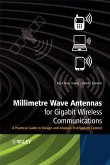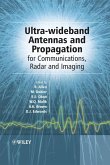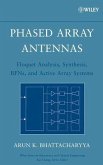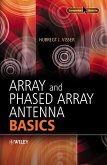136,99 €
136,99 €
inkl. MwSt.
Sofort per Download lieferbar

0 °P sammeln
136,99 €
Als Download kaufen

136,99 €
inkl. MwSt.
Sofort per Download lieferbar

0 °P sammeln
Jetzt verschenken
Alle Infos zum eBook verschenken
136,99 €
inkl. MwSt.
Sofort per Download lieferbar
Alle Infos zum eBook verschenken

0 °P sammeln
- Format: PDF
- Merkliste
- Auf die Merkliste
- Bewerten Bewerten
- Teilen
- Produkt teilen
- Produkterinnerung
- Produkterinnerung

Bitte loggen Sie sich zunächst in Ihr Kundenkonto ein oder registrieren Sie sich bei
bücher.de, um das eBook-Abo tolino select nutzen zu können.
Hier können Sie sich einloggen
Hier können Sie sich einloggen
Sie sind bereits eingeloggt. Klicken Sie auf 2. tolino select Abo, um fortzufahren.

Bitte loggen Sie sich zunächst in Ihr Kundenkonto ein oder registrieren Sie sich bei bücher.de, um das eBook-Abo tolino select nutzen zu können.
Describes the configuration and principles of a reflectarray antenna, its advantages over other antennas, the history of its development, analysis techniques, practical design procedures, bandwidth issues and wideband techniques, as well as applications and recent developments. Both authors are well respected practitioners who have build these antennas and developed them for space flight.
- Geräte: PC
- mit Kopierschutz
- eBook Hilfe
- Größe: 10.82MB
Andere Kunden interessierten sich auch für
![Antennas for Portable Devices (eBook, PDF) Antennas for Portable Devices (eBook, PDF)]() Antennas for Portable Devices (eBook, PDF)107,99 €
Antennas for Portable Devices (eBook, PDF)107,99 €![Millimetre Wave Antennas for Gigabit Wireless Communications (eBook, PDF) Millimetre Wave Antennas for Gigabit Wireless Communications (eBook, PDF)]() Kao-Cheng HuangMillimetre Wave Antennas for Gigabit Wireless Communications (eBook, PDF)103,99 €
Kao-Cheng HuangMillimetre Wave Antennas for Gigabit Wireless Communications (eBook, PDF)103,99 €![Ultra-Wideband Antennas and Propagation (eBook, PDF) Ultra-Wideband Antennas and Propagation (eBook, PDF)]() Ultra-Wideband Antennas and Propagation (eBook, PDF)123,99 €
Ultra-Wideband Antennas and Propagation (eBook, PDF)123,99 €![Phased Array Antennas (eBook, PDF) Phased Array Antennas (eBook, PDF)]() Arun K. BhattacharyyaPhased Array Antennas (eBook, PDF)183,99 €
Arun K. BhattacharyyaPhased Array Antennas (eBook, PDF)183,99 €![Conformal Array Antenna Theory and Design (eBook, PDF) Conformal Array Antenna Theory and Design (eBook, PDF)]() Lars JosefssonConformal Array Antenna Theory and Design (eBook, PDF)141,99 €
Lars JosefssonConformal Array Antenna Theory and Design (eBook, PDF)141,99 €![Array and Phased Array Antenna Basics (eBook, PDF) Array and Phased Array Antenna Basics (eBook, PDF)]() Hubregt J. VisserArray and Phased Array Antenna Basics (eBook, PDF)123,99 €
Hubregt J. VisserArray and Phased Array Antenna Basics (eBook, PDF)123,99 €![Compact and Broadband Microstrip Antennas (eBook, PDF) Compact and Broadband Microstrip Antennas (eBook, PDF)]() Kin-Lu WongCompact and Broadband Microstrip Antennas (eBook, PDF)155,99 €
Kin-Lu WongCompact and Broadband Microstrip Antennas (eBook, PDF)155,99 €-
-
-
Describes the configuration and principles of a reflectarray antenna, its advantages over other antennas, the history of its development, analysis techniques, practical design procedures, bandwidth issues and wideband techniques, as well as applications and recent developments. Both authors are well respected practitioners who have build these antennas and developed them for space flight.
Dieser Download kann aus rechtlichen Gründen nur mit Rechnungsadresse in A, B, BG, CY, CZ, D, DK, EW, E, FIN, F, GR, HR, H, IRL, I, LT, L, LR, M, NL, PL, P, R, S, SLO, SK ausgeliefert werden.
Produktdetails
- Produktdetails
- Verlag: Wiley
- Seitenzahl: 232
- Erscheinungstermin: 28. Juni 2008
- Englisch
- ISBN-13: 9780470178768
- Artikelnr.: 37290749
- Verlag: Wiley
- Seitenzahl: 232
- Erscheinungstermin: 28. Juni 2008
- Englisch
- ISBN-13: 9780470178768
- Artikelnr.: 37290749
- Herstellerkennzeichnung Die Herstellerinformationen sind derzeit nicht verfügbar.
John Huang, PhD, has been with the Jet Propulsion Laboratory, California Institute of Technology, since 1980, where his research activities involve microstrip antennas, mobile vehicle antennas, antenna miniaturization techniques, spacecraft antennas, phased arrays, reflectarrays, and inflatable antennas. He pioneered the development of several major antenna technologies, such as the microstrip reflectarray and the inflatable array antenna. Dr. Huang, an IEEE Fellow, has published extensively and received four U.S. patents and more than twenty NASA Certificates of Recognition. José A. Encinar, PhD, has been at Universidad Politécnica de Madrid since 1980, where he became a Professor of the Electromagnetism and Circuit Theory Department in 1991. His research interests include numerical techniques for the analysis and design of multi-layer periodic structures, frequency selective surfaces, printed arrays, and reflectarrays. He has published extensively and holds three patents on array and reflectarray antennas. Dr. Encinar was a co-recipient of the 2005 H. A. Wheeler Applications Prize Paper Award, and the 2007 S. A. Schelkunoff Transactions Prize Paper Award, given by IEEE Antennas and Propagation Society.
Preface.
Acknowledgments.
1. Introduction to Refl ectarray Antenna.
1.1 Description of Reflectarray.
1.2 Printed Reflectarray.
References.
2. Development History.
2.1 Early Innovations and Developments.
2.2 Recent Developments.
2.3 Comparison with Similar Technologies.
References.
3. Antenna Analysis Techniques.
3.1 Introduction.
3.2 Overview of Analysis Techniques.
3.3 Phase-Shift Distribution.
3.4 Analysis of Rectangular Patches with Attached Stubs.
3.5 Full-Wave Analysis of Multilayer Periodic Structures.
3.6 Phase-Shifter Element Based on Single and Stacked Variable-Sized
Patches.
3.7 Phase-Shifter Element Based on Aperture-Coupled Patches.
3.8 Feed Model and Radiation Patterns.
References.
4. Practical Design Approach.
4.1 Element Effects and Selection.
4.2 Path Length and Phase Delay Calculation.
4.3 Radiation Pattern Calculation.
4.4 Refl ectarray Geometry Design.
4.5 Refl ectarray Power Handling.
References.
5. Broadband Techniques.
5.1 Bandwidth Limitation by the Refl ectarray Element.
5.2 Broadband Phase-Shifter Elements.
5.3 Bandwidth Limitation by Differential Spatial Phase Delay.
5.4 Broadband Techniques for Large Refl ectarrays.
References.
6. Dual-Band Reflectarray.
6.1 Dual-Band with a Single-Layer Substrate.
6.2 Dual-Band with Two-Layer Substrates.
6.3 Multiband Refl ectarray with More than Two Frequencies.
References.
7. Recent and Future Applications.
7.1 Infl atable/Thin-Membrane Refl ectarrays.
7.2 Contoured Beam Refl ectarrays for Space Applications.
7.3 Multi-Beam Reflectarrays.
7.4 Amplifying Reflectarray.
7.5 Folded Compact Refl ectarray.
7.6 Cassegrain Offset-Fed Confi gurations.
7.7 Very Large Aperture Applications.
7.8 Beam Scanning Reflectarrays.
References.
Index.
Acknowledgments.
1. Introduction to Refl ectarray Antenna.
1.1 Description of Reflectarray.
1.2 Printed Reflectarray.
References.
2. Development History.
2.1 Early Innovations and Developments.
2.2 Recent Developments.
2.3 Comparison with Similar Technologies.
References.
3. Antenna Analysis Techniques.
3.1 Introduction.
3.2 Overview of Analysis Techniques.
3.3 Phase-Shift Distribution.
3.4 Analysis of Rectangular Patches with Attached Stubs.
3.5 Full-Wave Analysis of Multilayer Periodic Structures.
3.6 Phase-Shifter Element Based on Single and Stacked Variable-Sized
Patches.
3.7 Phase-Shifter Element Based on Aperture-Coupled Patches.
3.8 Feed Model and Radiation Patterns.
References.
4. Practical Design Approach.
4.1 Element Effects and Selection.
4.2 Path Length and Phase Delay Calculation.
4.3 Radiation Pattern Calculation.
4.4 Refl ectarray Geometry Design.
4.5 Refl ectarray Power Handling.
References.
5. Broadband Techniques.
5.1 Bandwidth Limitation by the Refl ectarray Element.
5.2 Broadband Phase-Shifter Elements.
5.3 Bandwidth Limitation by Differential Spatial Phase Delay.
5.4 Broadband Techniques for Large Refl ectarrays.
References.
6. Dual-Band Reflectarray.
6.1 Dual-Band with a Single-Layer Substrate.
6.2 Dual-Band with Two-Layer Substrates.
6.3 Multiband Refl ectarray with More than Two Frequencies.
References.
7. Recent and Future Applications.
7.1 Infl atable/Thin-Membrane Refl ectarrays.
7.2 Contoured Beam Refl ectarrays for Space Applications.
7.3 Multi-Beam Reflectarrays.
7.4 Amplifying Reflectarray.
7.5 Folded Compact Refl ectarray.
7.6 Cassegrain Offset-Fed Confi gurations.
7.7 Very Large Aperture Applications.
7.8 Beam Scanning Reflectarrays.
References.
Index.
Preface.
Acknowledgments.
1. Introduction to Refl ectarray Antenna.
1.1 Description of Reflectarray.
1.2 Printed Reflectarray.
References.
2. Development History.
2.1 Early Innovations and Developments.
2.2 Recent Developments.
2.3 Comparison with Similar Technologies.
References.
3. Antenna Analysis Techniques.
3.1 Introduction.
3.2 Overview of Analysis Techniques.
3.3 Phase-Shift Distribution.
3.4 Analysis of Rectangular Patches with Attached Stubs.
3.5 Full-Wave Analysis of Multilayer Periodic Structures.
3.6 Phase-Shifter Element Based on Single and Stacked Variable-Sized
Patches.
3.7 Phase-Shifter Element Based on Aperture-Coupled Patches.
3.8 Feed Model and Radiation Patterns.
References.
4. Practical Design Approach.
4.1 Element Effects and Selection.
4.2 Path Length and Phase Delay Calculation.
4.3 Radiation Pattern Calculation.
4.4 Refl ectarray Geometry Design.
4.5 Refl ectarray Power Handling.
References.
5. Broadband Techniques.
5.1 Bandwidth Limitation by the Refl ectarray Element.
5.2 Broadband Phase-Shifter Elements.
5.3 Bandwidth Limitation by Differential Spatial Phase Delay.
5.4 Broadband Techniques for Large Refl ectarrays.
References.
6. Dual-Band Reflectarray.
6.1 Dual-Band with a Single-Layer Substrate.
6.2 Dual-Band with Two-Layer Substrates.
6.3 Multiband Refl ectarray with More than Two Frequencies.
References.
7. Recent and Future Applications.
7.1 Infl atable/Thin-Membrane Refl ectarrays.
7.2 Contoured Beam Refl ectarrays for Space Applications.
7.3 Multi-Beam Reflectarrays.
7.4 Amplifying Reflectarray.
7.5 Folded Compact Refl ectarray.
7.6 Cassegrain Offset-Fed Confi gurations.
7.7 Very Large Aperture Applications.
7.8 Beam Scanning Reflectarrays.
References.
Index.
Acknowledgments.
1. Introduction to Refl ectarray Antenna.
1.1 Description of Reflectarray.
1.2 Printed Reflectarray.
References.
2. Development History.
2.1 Early Innovations and Developments.
2.2 Recent Developments.
2.3 Comparison with Similar Technologies.
References.
3. Antenna Analysis Techniques.
3.1 Introduction.
3.2 Overview of Analysis Techniques.
3.3 Phase-Shift Distribution.
3.4 Analysis of Rectangular Patches with Attached Stubs.
3.5 Full-Wave Analysis of Multilayer Periodic Structures.
3.6 Phase-Shifter Element Based on Single and Stacked Variable-Sized
Patches.
3.7 Phase-Shifter Element Based on Aperture-Coupled Patches.
3.8 Feed Model and Radiation Patterns.
References.
4. Practical Design Approach.
4.1 Element Effects and Selection.
4.2 Path Length and Phase Delay Calculation.
4.3 Radiation Pattern Calculation.
4.4 Refl ectarray Geometry Design.
4.5 Refl ectarray Power Handling.
References.
5. Broadband Techniques.
5.1 Bandwidth Limitation by the Refl ectarray Element.
5.2 Broadband Phase-Shifter Elements.
5.3 Bandwidth Limitation by Differential Spatial Phase Delay.
5.4 Broadband Techniques for Large Refl ectarrays.
References.
6. Dual-Band Reflectarray.
6.1 Dual-Band with a Single-Layer Substrate.
6.2 Dual-Band with Two-Layer Substrates.
6.3 Multiband Refl ectarray with More than Two Frequencies.
References.
7. Recent and Future Applications.
7.1 Infl atable/Thin-Membrane Refl ectarrays.
7.2 Contoured Beam Refl ectarrays for Space Applications.
7.3 Multi-Beam Reflectarrays.
7.4 Amplifying Reflectarray.
7.5 Folded Compact Refl ectarray.
7.6 Cassegrain Offset-Fed Confi gurations.
7.7 Very Large Aperture Applications.
7.8 Beam Scanning Reflectarrays.
References.
Index.







